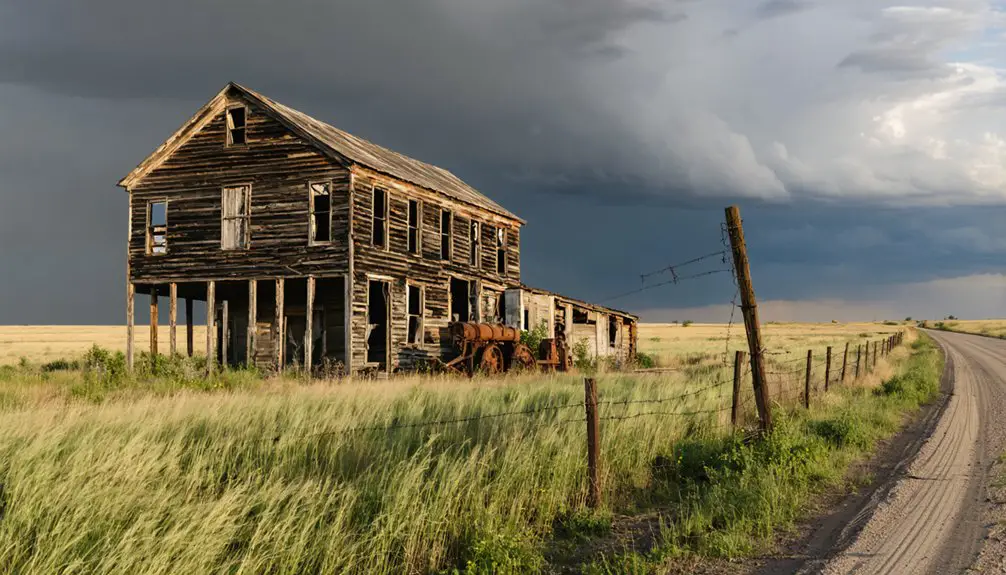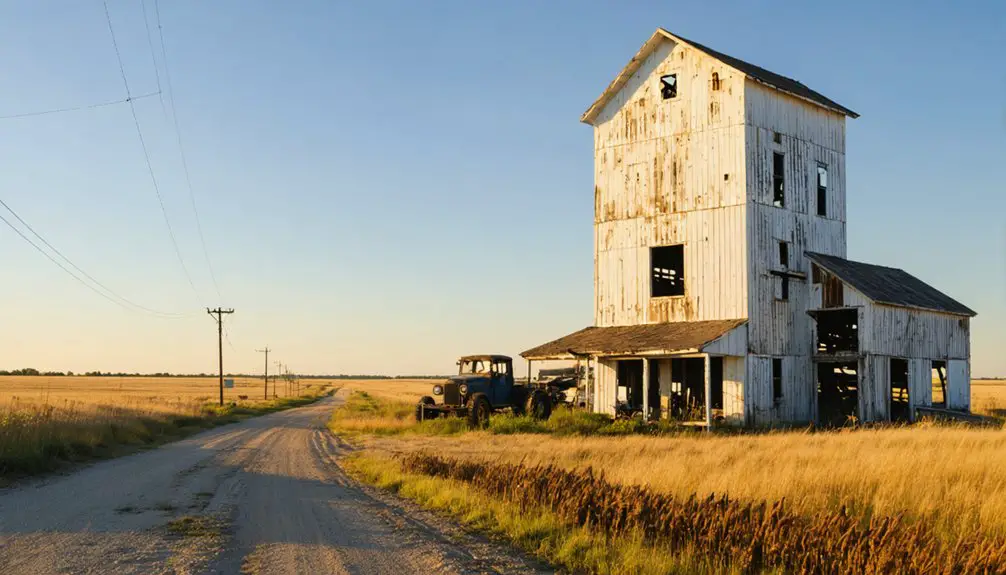You’ll find Tagus nestled in north-central North Dakota, where this former railroad town peaked at 140 residents back in 1940. Founded in 1900 along the Great Northern Railway, it served as an essential hub for farmers and rail workers until its decline in the 1960s. Today, the abandoned buildings and haunting ruins draw curious visitors, though local legends of phantom trains and eerie encounters suggest there’s more to this prairie ghost town than meets the eye.
Key Takeaways
- Tagus was established in 1900 as a railroad settlement along the Great Northern Railway and officially disincorporated in 1976.
- The town reached its peak population of 140 residents in 1940, declining to just 14 people by 1970.
- St. Olaf’s Lutheran Church, a significant landmark, burned down in 2001 and is now associated with supernatural legends.
- The abandoned town features scattered ruins, crumbling foundations, and a well-maintained cemetery documenting its history.
- Tagus has gained notoriety for reported paranormal activity, drawing ghost hunters and vandals who damage remaining structures.
From Railroad Settlement to Ghost Town
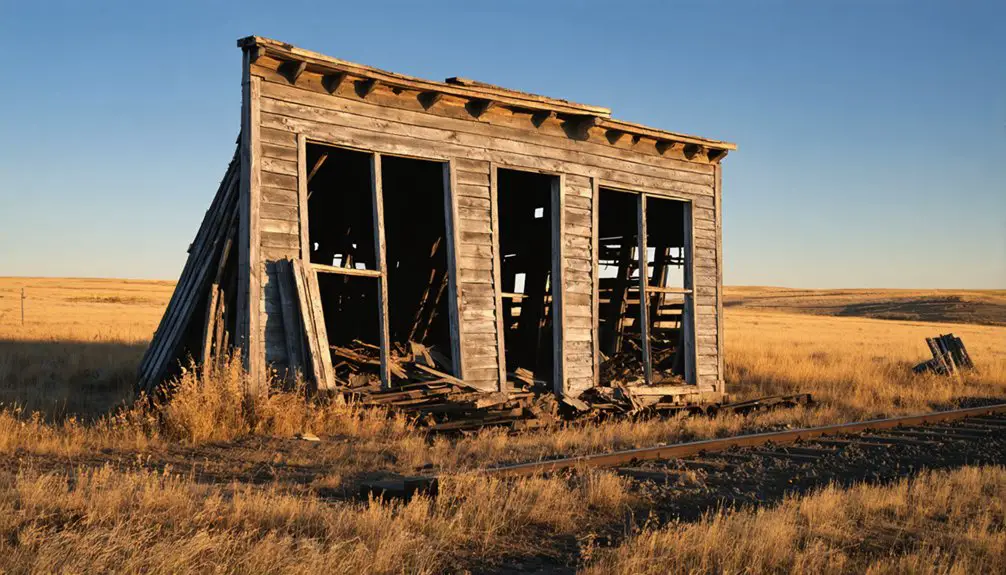
The whistle of the Great Northern Railway brought life to Tagus, North Dakota, in 1900. You’ll find this former railroad settlement about 40 miles west of Minot, where it started as Wallace before changing its name to avoid confusion with an Idaho town.
A railroad siding track was removed in the 1960s, marking another step in the town’s decline.
Tagus history shows how these prairie outposts lived and died by the rails. Like many frontier settlements, you’d have seen Tagus grow steadily through the early 1900s, peaking at 140 folks in 1940.
But the ghost town phenomena swept through as rail traffic dwindled and highways took over. By 1970, only 14 people called Tagus home. The town’s fate was sealed in 1976 when the last business closed its doors, and Tagus officially disincorporated, joining countless other railroad towns that time left behind.
Life Along the Great Northern Railway
If you’d worked for the Great Northern Railway in Tagus, you’d have spent your days maintaining track sections, loading coal into steam locomotives at the coaling station, or managing operations at the depot.
You’d have lived right there in company housing with other railroad families, forming a tight-knit community where everyone knew the sound of the evening freight rolling through.
The station bustled with activity as farmers brought their grain, townspeople picked up mail and supplies, and passengers waited on wooden benches for their trains to destinations east and west. Special trains carrying valuable silk cargo regularly passed through on their way from Seattle to Chicago.
In 1908, the railway company signed a promissory note with Great Northern Railway Company, hoping to keep operations running despite mounting financial difficulties.
Railroad Workers’ Daily Lives
Working along the Great Northern Railway meant embracing a life defined by steel, steam, and clockwork precision. You’d find yourself part of a diverse workforce where railroad labor stretched around the clock, with crews tackling physically demanding tasks in all weather conditions. Your efforts contributed to moving an impressive 19.5 billion ton miles of freight during peak wartime operations in 1944.
During the war years, you’d see more women workers joining the ranks as engine wipers, telegraphers, and accountants – like Bertha Gonder, who supported her large family through her railway work.
Life revolved around the railway’s rhythm, and you’d likely live in a railroad town where the sound of passing trains marked time.
Safety was paramount as you navigated the hazards of heavy machinery and steaming locomotives. Many families passed their railroad legacy through generations, with sons following their mothers’ footsteps into railway service.
Station Operations and Commerce
Life at Great Northern Railway stations hummed with activity around three essential components: water, coal, and grain. You’d see massive 100,000-gallon water tanks feeding thirsty steam locomotives, while coal chutes stood ready to fuel these iron workhorses.
The station infrastructure wasn’t just about moving trains – it was your gateway to prosperity. When you brought your grain to the elevator, you were plugging right into James J. Hill’s vision of agricultural commerce. Immigrant families from Germany and Scandinavia were actively recruited by the railroad to establish farms along the route.
The railway offered competitive freight services to keep your business, knowing that farmers were the lifeblood of these prairie towns. Signal towers kept the trains moving safely, while station crews hustled between the depot, bunkhouses, and maintenance facilities.
Everything worked together to keep your goods flowing and your community connected to distant markets.
Community Around the Tracks
When the Great Northern Railway laid tracks across North Dakota, it didn’t just build a transportation network – it created communities.
You’d find railway heritage embedded in every aspect of daily life, from the section foremen’s houses to the bustling bunkhouses where crews rested between shifts.
Your community’s heartbeat synced with the rhythm of the rails. Workers maintained water tanks and coal chutes while families built their lives around train schedules. The railway actively recruited German and Scandinavian immigrants to settle and farm along its lines.
The station became your social hub – you’d catch up on news as passengers came and went, or gather for community events timed to the railway’s pulse.
Despite the sometimes transient nature of railroad work, community resilience showed in how folks adapted to seasonal changes in both rail operations and farming cycles.
The Rise and Fall of a Prairie Community
Tucked away on the rolling prairies of North Dakota, the town of Tagus emerged in 1900 as one of many hopeful settlements along the Great Northern Railway’s transcontinental route.
You’ll find a story of community resilience in Tagus’s early years, as settlers built their dreams around the promising railroad hub, growing to 140 residents by 1940.
But like many prairie towns, Tagus couldn’t outrun the changing times.
As the railroad’s historical significance waned, so did the town’s fortunes. You can trace its decline through the numbers – from 101 residents in 1950 to just 14 by 1970.
When the last business shuttered in 1976, Tagus officially disappeared from the map, becoming part of Egan Township and leaving behind only memories, a cemetery, and weathered buildings as evidence of its prairie legacy.
Stories Behind the Town’s Name
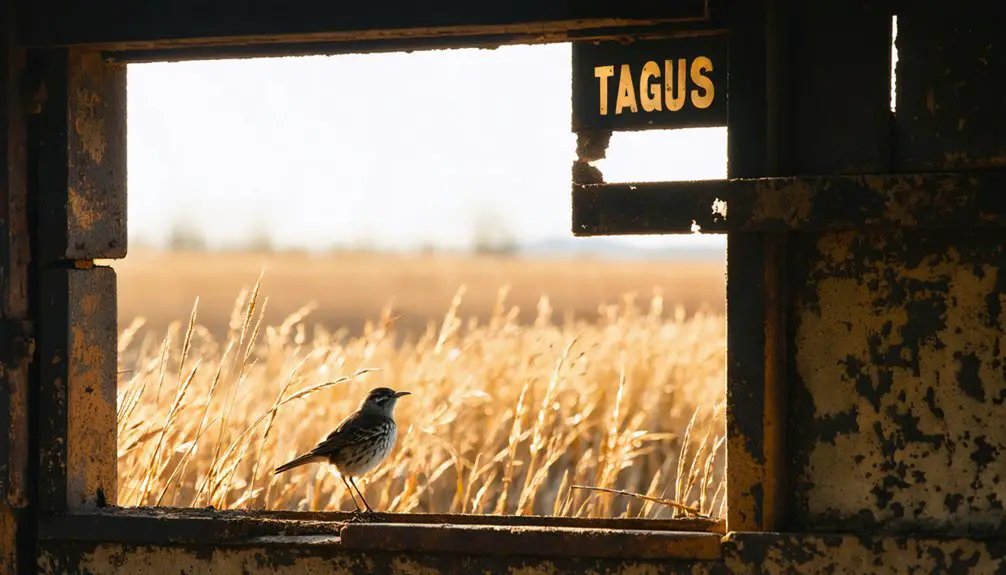
Behind every prairie town’s name lies a tale worth telling, and Tagus holds one of the more intriguing stories you’ll find in North Dakota.
Originally called Wallace, the town needed a new identity to avoid mix-ups with Wallace, Idaho, which was causing headaches for mail and freight deliveries along the Great Northern Railway.
The name they chose? Tagus, after Europe’s mighty Tagus River that flows through Spain and Portugal.
You won’t find any Spanish or Portuguese settlers in the town’s history, though. Instead, the exotic name reflects a common practice of the era – picking far-off places to give young prairie settlements a dash of worldly prestige.
It’s a choice that’s added to the town’s mystique, especially now that it’s known as a ghost town.
Haunting Tales and Local Legends
If you’re brave enough to visit Tagus at night, you’ll hear the mournful sounds of phantom trains rolling through and the eerie weeping coming from long-abandoned houses.
You’ll find the infamous “Stairway to Hell” that locals swear leads endlessly downward while voices from below call out to the living.
The town’s supernatural reputation as a gateway to darker dimensions only grew stronger after St. Olaf’s Lutheran Church burned in 2001, with its haunting history of upside-down crosses and whispered tales of occult gatherings.
Phantom Trains After Midnight
Among the most chilling legends surrounding Tagus’s abandoned railway line are tales of a phantom train that still rumbles through town long after midnight.
You’ll hear locals talk about phantom sightings when the moon’s high – ghostly whistles piercing the darkness and the unmistakable rumble of spectral trains rolling down tracks that haven’t seen real service in decades.
These eerie encounters trace back to Tagus’s roots as a Great Northern Railway settlement, where trains once brought life and prosperity to this prairie town.
While no official records confirm these supernatural occurrences, visitors swear they’ve heard the distinct sound of train wheels and whistles echoing through the empty landscape.
The phantom train’s presence adds another layer to the town’s reputation as a place where the past refuses to rest quietly.
Weeping From Empty Houses
The empty houses of Tagus hold more than just memories – they’re home to some of the eeriest sounds you’ll ever hear on the North Dakota prairie.
Visitors report weeping sounds and moans echoing through abandoned hallways, along with distant cries of infants that’ll make your hair stand on end.
These haunting tales gained even more weight after the burning of St. Olaf’s Lutheran Church in 2001, where upside-down crosses and rumors of dark rituals left their mark on local legend.
You won’t just hear the spirits – folks say you can feel them too. Unseen presences lurk in doorways, and some claim hellhounds prowl invisibly around the ruins.
The haunting atmosphere runs deep here, as if the town itself weeps for its lost community and fading history.
Gateway To Hell Stories
Lurking beneath Tagus’s abandoned structures lies what locals swear is a gateway straight to hell itself, centered around the ruins of St. Olaf’s Lutheran Church.
Before the church burned down in 2001, you’d find upside-down crosses marking its entrance, hinting at darker activities within. Folks say if you’d ventured down the church’s endless staircase, you’d hear the voices of damned souls crying out for salvation.
While officials blamed faulty wiring for the church fire, townsfolk know better – they’ll tell you about the satanic rituals and ghost sightings that plagued the building for decades.
Stories of animal sacrifices and devil worship have swirled since the 1970s, though no one’s ever proved them true. Yet something keeps drawing people to these ruins, despite warnings to stay away.
Abandoned Buildings and Historical Landmarks
Walking through Tagus today, you’ll find little more than scattered ruins and crumbling foundations where a bustling railroad town once stood.
The abandoned architecture tells the story of a community that peaked at 140 residents in 1940 before dwindling to just 14 souls by 1970. Among the most significant losses was St. Olaf’s Lutheran Church, which burned down in 2001, leaving only a memorial plaque to mark its historical significance.
You’ll spot a few occupied homesteads among the decay, including one distinctive country house with a turret.
Large old trees tower over the remnants of the former townsite along the BNSF Mainline. The well-maintained cemetery stands as the last true landmark, a poignant reminder of the vibrant community that once called Tagus home.
Vandalism and Modern-Day Challenges

Modern threats to Tagus stretch far beyond natural decay and abandonment.
You’ll find vandalism motivations deeply rooted in the town’s spooky reputation, with urban legends of satanic worship and paranormal activity drawing curious thrill-seekers.
The most destructive incidents include:
Tagus has suffered devastating blows to its heritage, with a series of destructive incidents stripping away its historic character.
- The 2001 church fire that destroyed the town’s last historic house of worship
- Repeated defacement with upside-down crosses and occult symbols
- Large-scale trespassing events, especially during Halloween
- Ongoing damage to remaining structures by ghost hunters
These days, you’ll need to watch your step – the few remaining residents don’t take kindly to trespassers.
They’ve been known to chase off unwanted visitors with their trucks and firearms, determined to protect what’s left of their vanishing town’s heritage.
The Legacy of Rural Migration
Like countless rural communities across North Dakota, Tagus stands as a stark reminder of the state’s dramatic rural migration patterns.
You’ll find its story echoes the broader shifts in rural demographics that transformed the state since the 1920s, when most farming communities reached their peak populations.
What you’re seeing in Tagus isn’t just abandonment – it’s the result of powerful economic challenges that pushed younger generations toward urban centers like Fargo and Bismarck.
As small farming became less viable and opportunities dwindled, folks had to make tough choices.
The same forces that filled Tagus with immigrant families and hopeful settlers in the early 1900s eventually pulled their children and grandchildren away, leaving behind empty buildings that tell the tale of changing times in America’s heartland.
Exploring the Ruins Today
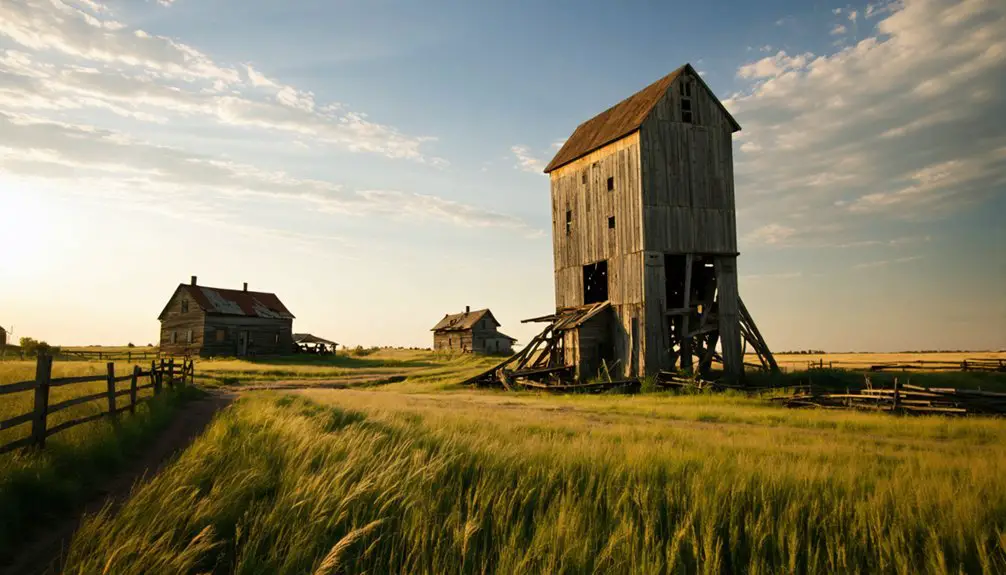
Today, when you venture into Tagus’s haunting remains, you’ll find a collection of weathered structures that paint a stark picture of rural decay.
Your Tagus exploration might lead you down paths where rusted automobiles rest like sleeping giants and dilapidated houses whisper tales of better days.
For those seeking ghostly encounters, locals warn about these hotspots:
- St. Olaf’s Church ruins, where the infamous “Stairway to Hell” legend was born
- The abandoned train tracks, home to phantom locomotive sightings
- Old farmsteads where strange sounds echo through empty rooms
- The memorial plaque marking where upside-down crosses once stood
While you’re free to wander these grounds, watch your step – unstable structures and harsh prairie winters have taken their toll on what’s left of this forgotten town.
Frequently Asked Questions
Are There Any Maps Showing the Original Layout of Tagus?
You won’t find any original historical maps showing Tagus’s town layout readily available, but you’ll need to dig through railroad archives, county records, or North Dakota historical societies to track one down.
What Happened to the Town’s Official Records After Disincorporation?
You’ll find most records got transferred to Mountrail County after 1976, though record preservation faced real challenges with vandalism and abandonment. Some files might’ve scattered between township and state archives.
Did Any Notable Historical Figures Ever Visit Tagus?
Hold your horses – you won’t find any famous visitors in the history books. Historical records don’t show any notable figures stopping by this small railroad town during its brief impact.
What Was the Average Property Value During the Town’s Peak?
You’re looking at modest property market values during the 1940s peak – probably a few hundred to thousand dollars for homes, reflecting the historical economy of small railroad towns in these parts.
Were There Any Significant Natural Disasters That Contributed to Tagus’s Decline?
You won’t find any big flood damage or drought impact in the records – Tagus’s decline came from economic changes and folks moving away, not Mother Nature’s fury at all.
References
- https://ghostsofnorthdakota892857007.wordpress.com/2016/03/22/tagus-nd/
- https://en.wikipedia.org/wiki/Tagus
- https://myamericanodyssey.com/the-gateway-to-hell-in-tagus-north-dakota/
- https://www.ghosttowns.com/states/nd/tagus.html
- https://www.youtube.com/watch?v=FJVZIt9f2Xw
- https://www.history.nd.gov/hp/PDFinfo/North-Dakota-Railroads-MPDF-Final-corrected.pdf
- https://commons.und.edu/cgi/viewcontent.cgi?filename=9&article=1000&context=oers&type=additional
- https://www.ndstudies.gov/gr4/early-settlement-north-dakota/part-1-early-settlement-north-dakota/section-9-railroads
- https://commons.und.edu/theses/5790/
- https://www.griggscountyhistoricalsociety.com/online/hannaford_centennial/hannaford/great_northern_railroad.php
